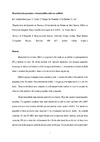Identificador persistente para citar o vincular este elemento:
https://accedacris.ulpgc.es/jspui/handle/10553/42002
| Campo DC | Valor | idioma |
|---|---|---|
| dc.contributor.author | Alemán-Domínguez, Maria Elena | en_US |
| dc.contributor.author | Giusto, Elena | en_US |
| dc.contributor.author | Ortega, Zaida | en_US |
| dc.contributor.author | Tamaddon, Maryam | en_US |
| dc.contributor.author | Benítez, Antonio Nizardo | en_US |
| dc.contributor.author | Liu, Chaozong | en_US |
| dc.date.accessioned | 2018-09-26T12:16:30Z | - |
| dc.date.available | 2018-09-26T12:16:30Z | - |
| dc.date.issued | 2019 | en_US |
| dc.identifier.issn | 1552-4973 | en_US |
| dc.identifier.other | WoS | - |
| dc.identifier.uri | https://accedacris.ulpgc.es/handle/10553/42002 | - |
| dc.description.abstract | Microcrystalline cellulose (MCC) is proposed in this study as an additive in polycaprolactone (PCL) matrices to obtain 3D printed scaffolds with improved mechanical and biological properties. Improving the mechanical behavior and the biological performance of polycaprolactone-based scaffolds allows to increase the potential of these structures for bone tissue engineering. Different groups of samples were evaluated in order to analyse the effect of the additive in the properties of the PCL matrix. The concentrations of MCC in the groups of samples were 0, 2, 5 and 10% (w/w). These combinations were subjected to a thermogravimetric analysis in order to evaluate the influence of the additive in the thermal properties of the composites. 3D printed scaffolds were manufactured with a commercial 3D printer based on fused deposition modelling. The operation conditions have been established in order to obtain scaffolds with a 0/90° pattern with pore sizes between 450-500 µm and porosity values between 50-60%. The mechanical properties of these structures were measured in the compression and flexural modes. The scaffolds containing 2% and 5% MCC have higher flexural and compression elastic modulus, although those containing 10% do not show this reinforcement effect. On the other hand, the proliferation of sheep bone marrow cells on the proposed scaffolds was evaluated over 8 days. The results show that the proliferation is significantly better (p<0.05) on the group of samples containing 2% MCC. Therefore, these scaffolds (PCL:MCC 98:2) have suitable properties to be further evaluated for bone tissue engineering applications. | en_US |
| dc.language | eng | en_US |
| dc.relation | Biomaterials And Additive Manufacturing: Osteochondral Scaffold Innovation Applied To Osteoarthritis | en_US |
| dc.relation.ispartof | Journal of Biomedical Materials Research - Part B Applied Biomaterials | en_US |
| dc.source | Journal of Biomedical Materials Research - Part B Applied Biomaterials[ISSN 1552-4973], v. 107 (3), p. 521-528 | en_US |
| dc.subject | 3313 Tecnología e ingeniería mecánicas | en_US |
| dc.subject.other | Tissue Engineering | en_US |
| dc.subject.other | Ingeniería de tejidos | en_US |
| dc.subject.other | Regeneración de hueso | en_US |
| dc.subject.other | Bone replacement | en_US |
| dc.title | 3D printed polycaprolactone-microcrystalline cellulose scaffolds | en_US |
| dc.title.alternative | Three-dimensional printed polycaprolactone-microcrystalline cellulose scaffolds | en_US |
| dc.type | info:eu-repo/semantics/Article | en_US |
| dc.type | Article | en_US |
| dc.identifier.doi | 10.1002/jbm.b.34142 | en_US |
| dc.identifier.scopus | 85046545465 | - |
| dc.identifier.isi | 000461683400006 | - |
| dc.contributor.authorscopusid | 56097219900 | - |
| dc.contributor.authorscopusid | 6506701605 | - |
| dc.contributor.authorscopusid | 57212176037 | - |
| dc.contributor.authorscopusid | 36241994700 | - |
| dc.contributor.authorscopusid | 55581409800 | - |
| dc.contributor.authorscopusid | 57210096811 | - |
| dc.contributor.authorscopusid | 57188879979 | - |
| dc.identifier.eissn | 1552-4981 | - |
| dc.description.lastpage | 528 | en_US |
| dc.identifier.issue | 3 | - |
| dc.description.firstpage | 521 | en_US |
| dc.relation.volume | 107 | en_US |
| dc.investigacion | Ingeniería y Arquitectura | en_US |
| dc.type2 | Artículo | en_US |
| dc.contributor.daisngid | 8698575 | - |
| dc.contributor.daisngid | 3882185 | - |
| dc.contributor.daisngid | 2273115 | - |
| dc.contributor.daisngid | 12148725 | - |
| dc.contributor.daisngid | 579452 | - |
| dc.contributor.daisngid | 29692247 | - |
| dc.utils.revision | Sí | en_US |
| dc.contributor.wosstandard | WOS:Aleman-Dominguez, ME | - |
| dc.contributor.wosstandard | WOS:Giusto, E | - |
| dc.contributor.wosstandard | WOS:Ortega, Z | - |
| dc.contributor.wosstandard | WOS:Tamaddon, M | - |
| dc.contributor.wosstandard | WOS:Benitez, AN | - |
| dc.contributor.wosstandard | WOS:Liu, CZ | - |
| dc.date.coverdate | Abril 2019 | en_US |
| dc.identifier.ulpgc | Sí | en_US |
| dc.contributor.buulpgc | BU-ING | en_US |
| dc.description.sjr | 0,659 | |
| dc.description.jcr | 2,831 | |
| dc.description.sjrq | Q2 | |
| dc.description.jcrq | Q2 | |
| dc.description.scie | SCIE | |
| item.fulltext | Con texto completo | - |
| item.grantfulltext | open | - |
| crisitem.author.dept | GIR Fabricación integrada y avanzada | - |
| crisitem.author.dept | GIR Fabricación integrada y avanzada | - |
| crisitem.author.dept | Departamento de Ingeniería de Procesos | - |
| crisitem.author.dept | GIR Fabricación integrada y avanzada | - |
| crisitem.author.dept | Departamento de Ingeniería de Procesos | - |
| crisitem.author.orcid | 0000-0002-2254-9905 | - |
| crisitem.author.orcid | 0000-0002-7112-1067 | - |
| crisitem.author.orcid | 0000-0001-5711-6395 | - |
| crisitem.author.parentorg | Departamento de Ingeniería Mecánica | - |
| crisitem.author.parentorg | Departamento de Ingeniería Mecánica | - |
| crisitem.author.parentorg | Departamento de Ingeniería Mecánica | - |
| crisitem.author.fullName | Alemán Domínguez, María Elena | - |
| crisitem.author.fullName | Ortega Medina, Zaida Cristina | - |
| crisitem.author.fullName | Benítez Vega, Antonio Nizardo | - |
| crisitem.project.principalinvestigator | Monzón Verona, Mario Domingo | - |
| Colección: | Artículos | |
Citas SCOPUSTM
53
actualizado el 08-jun-2025
Citas de WEB OF SCIENCETM
Citations
48
actualizado el 12-ene-2026
Visitas
231
actualizado el 09-ene-2026
Descargas
421
actualizado el 09-ene-2026
Google ScholarTM
Verifica
Altmetric
Comparte
Exporta metadatos
Los elementos en ULPGC accedaCRIS están protegidos por derechos de autor con todos los derechos reservados, a menos que se indique lo contrario.
